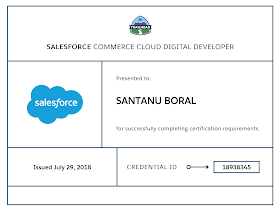Exam Outline
- Content: 60 multiple-choice/multiple-select questions * (5 unscored questions will be added)
- Time allotted to complete the exam: 105 minutes (time allows for unscored questions)
- Passing Score: 70%
- Registration fee: USD 200, plus applicable taxes as required per local law
- Retake fee: USD 100, plus applicable taxes as required per local law
- Delivery options: Proctored exam delivered onsite at a testing center or in an online proctored environment. Click here for information on scheduling an exam.
- References: No hard-copy or online materials may be referenced during the exam.
- Prerequisite: None
I have faced 65 questions, some of the questions are descriptive and contained long code script, which took time to read and understand the question.
Above all, it's good to see me passed.
Prerequisites
You need a sandbox and access to Commerce Cloud Account Manager. If your company is Salesforce Partner then requesting to Salesforce will have access.
Topics I have received on Exam
- How to connect sandbox from UXStudio.
- Lot's of question on Import and Export, (including Site, Product etc)
- What are different type of includes and for which purpose it is being used. Read on <include>, require()
- Content Link functions like $url()$, $httpUrl()$, $httpsUrl()$, $include()$
- Different types of scopes like Session, Request, Page and when to use what.
- How to show error message when required mandatory input has not given.
- How to create an instance of custom object.
- Write a correct code to show Debug message.
- Log file formats.
- Accessing values for multi-lingual requirements.
- Creating and using custom tags.
- CSRF and how to prevent those.
- Quota and what happens when it is exceeded and what needs to be done.
- Cache: how to define cache
- How to identity the cache related issues.
- Creating custom attributes and how to make it indexed.
- Open Commerce API (OCAPI) and calling webservices using SOAP, REST etc.
- Correct syntax using GET and POST with authentication.
- Hooks: Which hook needs to be used given a certain use case.
Hope, this will help you to prepare for the exam.

